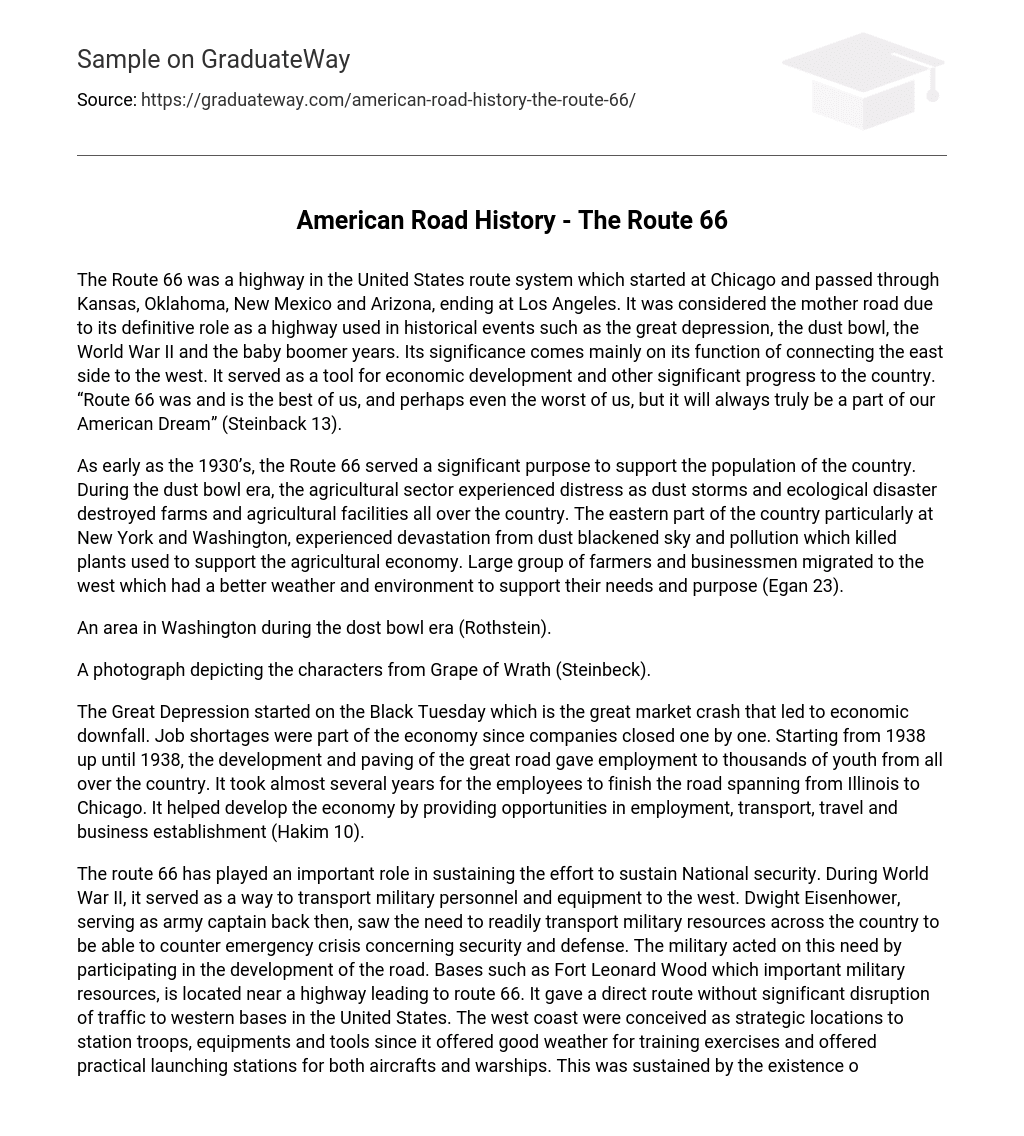The Route 66 was a highway in the United States route system which started at Chicago and passed through Kansas, Oklahoma, New Mexico and Arizona, ending at Los Angeles. It was considered the mother road due to its definitive role as a highway used in historical events such as the great depression, the dust bowl, the World War II and the baby boomer years. Its significance comes mainly on its function of connecting the east side to the west. It served as a tool for economic development and other significant progress to the country. “Route 66 was and is the best of us, and perhaps even the worst of us, but it will always truly be a part of our American Dream” (Steinback 13).
As early as the 1930’s, the Route 66 served a significant purpose to support the population of the country. During the dust bowl era, the agricultural sector experienced distress as dust storms and ecological disaster destroyed farms and agricultural facilities all over the country. The eastern part of the country particularly at New York and Washington, experienced devastation from dust blackened sky and pollution which killed plants used to support the agricultural economy. Large group of farmers and businessmen migrated to the west which had a better weather and environment to support their needs and purpose (Egan 23).
An area in Washington during the dost bowl era (Rothstein).
A photograph depicting the characters from Grape of Wrath (Steinbeck).
The Great Depression started on the Black Tuesday which is the great market crash that led to economic downfall. Job shortages were part of the economy since companies closed one by one. Starting from 1938 up until 1938, the development and paving of the great road gave employment to thousands of youth from all over the country. It took almost several years for the employees to finish the road spanning from Illinois to Chicago. It helped develop the economy by providing opportunities in employment, transport, travel and business establishment (Hakim 10).
The route 66 has played an important role in sustaining the effort to sustain National security. During World War II, it served as a way to transport military personnel and equipment to the west. Dwight Eisenhower, serving as army captain back then, saw the need to readily transport military resources across the country to be able to counter emergency crisis concerning security and defense. The military acted on this need by participating in the development of the road. Bases such as Fort Leonard Wood which important military resources, is located near a highway leading to route 66. It gave a direct route without significant disruption of traffic to western bases in the United States. The west coast were conceived as strategic locations to station troops, equipments and tools since it offered good weather for training exercises and offered practical launching stations for both aircrafts and warships. This was sustained by the existence of route 66 (Hakim 12).
Fort Leonard Wood near a highway leading to Route 66
The World War II development of the Route 66 proved to be one of the proponents to the end of the Great depression by providing the greatest manpower utilization and deployment from the civilian sector. Billions of dollars were distributed to the working class from Chicago to Los Angeles for their participation with the maintenance and development of the route as they struggle to live pass the Great Depression. The Route 66 became part of economic recovery and served as a tool to support the American Military during the war (Rittenhouse 42).
The baby boom years, recovery form war proved to be significantly progressive as business all over the country were given a large market including the war torn Europe, Asia and other countries. Increased production was needed to serve as exported goods. The United States of America supplied other nations to help them repair their infrastructures. Route 66 served as a highway to provide transport of goods and materials all over the country efficiently and practically. This enabled the business process to flourish (Scott 32).
Post war businesses along route 66 including motels and lodgings, gasoline stations and stores flourished since travel at this highway became a daily occurrence for the population. Facilities along its route were also established and were sustained for decades due to its accessibility. The migrating groups were also given easy access of going from the east to the west. Tourism became a practical source of business. The catch phrase “find your way at route 66” (Cole) became famous due to the implications of route 66 to the lives of Americans during that time.
Today route 66 is a significant and historical part of the history of the United States as it served as a sustaining force during the great depression, the war and post war. It symbolized hope during the hard era and paved the way for reformation. It helped developed the different aspects of society.
REFERENCES
Steinback, John. The Grapes of Wrath. The Viking Press, 1939.
Egan, Timothy. The Worst Hard Time: The Untold Story of Those Who Survived The Great American Dust Bowl. Houghton Mifflin Company, New York, 2006.
Hakim, Joy. A History of Us: War, Peace and all that Jazz. New York: Oxford University Press, 1995.
Scott, Quinta. Route 66: A Highway and Its People. Oklahoma: University of Oklahoma Press, 1988
Rittenhouse, Jack D. A Guide Book to Highway 66. Albuquerque. New Mexico: University of New Mexico Press, 1989
Cole, Nat King. Get you’re kicks at Route 66. 1946
Images:
Ford, John. The Grapes of Wrath: Movie, 1940, (http://www.imdb.com/media/rm1783404544/tt0032551)
Rothstein Arthur, for the Farm Security Administration, April 1936, (http://www.shorpy.com/node/4263?size=_original).
Fort Leonard Wood, 1936, (http://www.visitpulaskicounty.org/auto-route66.html)





